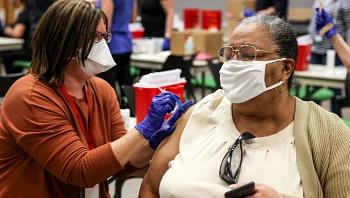Headache and flu-like side effects common
Systemic side effects occurred in about 55 percent of people who received the vaccine.
The most commonly reported ones were headache, fatigue, and muscle pain, and in smaller numbers of people, nausea and fever.
These began on average 2 days after vaccination. Fatigue, headache, and muscle ache lasted on average 2 days. Nausea and fever lasted on average 1 day.
The onset and duration of systemic side effects varied, although fewer than 2 percent of people experienced systemic side effects lasting longer than 7 days.
Less than 2 percent of the systemic side effects were severe, with the most common being fatigue, muscle pain, and fever.
All of the systemic side effects were reported more frequently among younger adults compared to older adults. The one exception was nausea, which occurred at about the same rate in both groups.
Around one-fifth of people reported using a medication to relieve their pain or fever within 1 week of their vaccination. This was more common among younger adults.
How does J&J compare to the mRNA vaccines?
While it can be difficult to compare the efficacy of vaccines tested in different clinical trials under different conditions, Katelyn Jetelina, PhD, an assistant professor at University of Texas Health School of Public Health in Dallas, says side effects are easier to compare.
“Because the clinical trials were large and randomized,” she said, “we are confident that these side effects aren’t due to individual variation, but rather closer to the ‘true’ experience for vaccinated adults.”
The type of side effects seen with the J&J vaccine are in line with those experienced by people who received one of the mRNA vaccines.
However, “in the clinical trials [for the J&J vaccine], fewer people reported side effects, relative to Pfizer or Moderna, especially if we compare J&J to the second dose of Pfizer or Moderna,” Jetelina said.
Over 80 percent of people who received the Moderna-NIAID vaccineTrusted Source experienced local reactions after either dose. It was about the same for the Pfizer-BioNTech vaccineTrusted Source . This is higher than seen with the J&J vaccine.
For the Moderna-NIAID vaccine, about 55 percent of people experienced systemic reactions after the first dose — similar to the J&J vaccine — but 80 percent experienced them after the second dose.
The Pfizer-BioNTech vaccine also had a higher rate of systemic reactions than the J&J vaccine, especially after the second dose.
Lee says the stronger side effects after the second dose of the mRNA vaccines is “probably because your immune system is primed from receiving the first dose.”
Clinical trials provide important information about the safety of vaccines, but the federal government continues to monitor vaccines after they’re approved.
This includes monitoring vaccines through the V-safe smartphone appTrusted Source and the Vaccine Adverse Event Reporting System, both of which allow the general public to report side effects they experience after a vaccine.
“Any time you have an adverse event from a vaccine, it’s important to report it,” said Lee, “because we really want to see how the vaccine behaves in a broader population and over time.”





